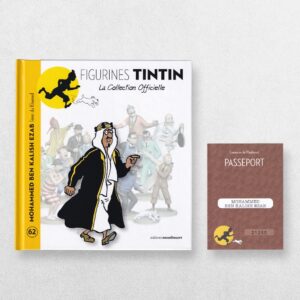Tintin By Plane – 29 – The Emir’s Fighter Plane – L’Avion De Chasse De L’Emir – En Avion Tintin
Hergé & Editions Moulinsart
£65.00
Availability: In stock
Product Description
Tintin By Plane – 29 – The Emir’s Fighter Plane – L’Avion De Chasse De L’Emir – En Avion Tintin
Author: Hergé & Editions Moulinsart
Price: £65.00
Publisher: Editions Moulinsart
Publication date: 2015
Format: Original pictorial boards with plane on plinth
Condition: In near fine condition
Illustrations: Illustrated throughout
Description:
Original pictorial boards. Text in French. Includes the accompanying model and figurine. One from the collection of 50 books and models. Very slight wear. In very near fine, clean condition overall.
Tintin in The Land of Black Gold: A Brief Account
Tintin in the Land of Black Gold is one of Hergé’s most politically charged Tintin adventures. First conceived in the late 1930s and completed after the Second World War, it explores oil politics, sabotage of fuel supplies, and rising tension in the Middle East.
The story reflects the pre-war climate of global industrial rivalry and the geopolitical significance of oil, although its tone remains adventurous rather than overtly didactic.
Plot Summary
Sabotage and Mystery in Europe
The story opens in Europe, where motor cars, aircraft and even children’s toys begin mysteriously exploding. Tintin learns that petrol supplies are being tampered with — a dangerous additive is destabilising fuel worldwide.
The mystery signals a looming international crisis, and Tintin immediately suspects organised sabotage.
The Journey East
Tintin travels to the Middle East (in the fictional Emirate of Khemed), following clues that point towards criminals meddling with petroleum interests. During the journey, he encounters Thomson and Thompson, who provide comic relief while attempting to investigate radio code messages.
On arrival in Khemed, Tintin quickly finds himself caught between rival factions, oil companies and covert operators.
Political Intrigue in Khemed
Khemed is ruled by Emir Ben Kalish Ezab, a charismatic and somewhat eccentric leader, assisted by his truculent young son, Prince Abdullah, whose fondness for outrageous practical jokes complicates matters at every turn.
Opposing the Emir is the rebel Sheikh Bab El Ehr, part of a wider plot to seize power. Both sides are linked to the struggle for control over oil concessions — with foreign powers watching closely.
The Villain Revealed
Tintin soon discovers that the fuel sabotage is masterminded by the sinister Dr Müller, a recurring antagonist in the Tintin canon. Müller has partnered with Bab El Ehr in a bid to destabilise global petroleum markets.
The plot involves adulterating petrol with a compound that causes engines to explode, threatening economic chaos and political collapse.
Kidnapping and Escape
Tintin is captured, escapes through deserts and dunes, and survives several assassination attempts. Along the way he encounters Captain Haddock (in later editions — early versions pre-date Haddock’s introduction), and relies on bravery, improvisation and moral clarity to stay ahead of his enemies.
Prince Abdullah’s pranks, though irritating, end up unwittingly aiding Tintin on more than one occasion.
Final Confrontation
Tintin ultimately exposes the sabotage ring. The Emir retains power, Dr Müller is thwarted, and oil shipments return to normal. The story concludes with a sense of fragile stability restored — a hallmark of Hergé’s subtle political balancing.
Themes
Oil Politics
Unlike the purely adventurous early books, this story acknowledges real-world power, unrest and industrial espionage surrounding oil.
International Rivalry
The tensions between fictional powers mirror pre-war European competition in the Middle East.
Comic and Dramatic balance
Despite serious themes, Hergé offsets tension with comedy — especially through Abdullah’s mischievous antics and the bumbling detectives, Thomson and Thompson.
Cultural Representation
As with many early Tintin adventures, the depiction of the Middle East reflects mid-20th-century European perspectives. Later editions softened certain portrayals and dialogue to bring them closer to modern sensitivities.
Artistic and Historical Notes
- The story was interrupted by the Second World War; Hergé resumed and reworked it afterwards.
- Captain Haddock’s presence depends on edition: early versions lack him; later album editions integrate him.
- The serial and album forms differ in dialogue, pacing and some political nuances.
It stands as a key transitional work between Tintin’s early straightforward adventures and the more psychologically rich, meticulously researched later albums.
In Summary
Tintin in the Land of Black Gold blends political intrigue, early petroleum geopolitics and brisk adventure storytelling. It highlights Tintin’s unwavering moral compass while acknowledging the complexities of global resource competition — all presented with clarity, humour and visual precision typical of Hergé’s ligne claire style.
Why Buy from Us?
At Hornseys, we are committed to offering items that meet the highest standards of quality and authenticity. Our collection of objects and rare books are carefully curated to ensure each edition is a valuable piece of bibliographical history. Here’s what sets us apart:
- Authenticity and Provenance: Each item is meticulously researched and verified for authenticity and collation.
- Expert Curation: Our selection process focuses on significance, condition, and rarity, resulting in a collection that is both diverse and distinguished.
- Customer Satisfaction: We aim to provide an exceptional customer experience, from detailed descriptions to secure and prompt delivery of your purchase.
- Returns Policy: We offer an unconditional guarantee on every item. If you wish to return an item, it may be sent back to us within fourteen days of receipt. Please notify us in advance if you wish to do so. The item must be returned in the same condition as it was sent for a full refund.
Cataloguer: Daniel Hornsey
Daniel Hornsey has specialised in fine and rare books, ephemera, and collectors’ editions for over thirty years. As a long-standing member of the antiquarian book trade, he has advised private collectors, curated catalogues, and sourced works for leading dealers, libraries and institutions across the world.
Hornseys’ exhibit regularly at book and map fairs in London and throughout the UK and are members of the Provincial Booksellers Fairs Association, the PBFA.
His fascination with Hergé’s work — especially ‘The Adventures of Tintin’ — began in childhood. Daniel recalls reading Tintin in original European editions and quickly recognising that these were not merely children’s books, but finely illustrated narratives crafted with artistic depth and wit.
As noted by the Musée Hergé in Louvain-la-Neuve, Hergé’s ‘ligne claire’ style has influenced generations of European comic artists and his original drawings and paintings command very high prices with his painting of ‘The Blue Lotus’ jar fetching £2.8m at auction in 2021.
By presenting these works through Hornseys’, he hopes to contribute to the continued appreciation of one of the 20th century’s most influential illustrators, helping new generations discover the artistry and legacy of Hergé.
Related products
Paul Blake Or The Story Of A Boy’s Perils In The Islands Of Corsica And Monte Cristo
£125.00Elwes, Alfred (Leighton Binding)
You may also like…
Tintin By Plane – 27 – The Air India Flight From Tintin In Tibet – Le Vol Air India De Tintin Au Tibet – En Avion Tintin
£85.00Hergé & Editions Moulinsart
Tintin By Plane – 26 – Le Stratonef H-22 De Jo Et Zette – En Avion Tintin
£65.00Hergé & Editions Moulinsart
Tharkey The Loyal Sherpa Guide – Figurines Tintin La Collection Officielle – 109 – Tharkey Le Fidele Sherpa
£125.00Hergé & Editions Moulinsart
Fakir Cipaçalouvishni – Figurines Tintin La Collection Officielle – 107 – Le Fakir Cipaçalouvishni
£75.00Hergé & Editions Moulinsart
Sheikh Bab El Ehr The Rebel Leader – Figurines Tintin La Collection Officielle – 106 – Le Cheikh Bab El Ehr L’Insurgé
£100.00Hergé & Editions Moulinsart
Chiquito Alias Rupac Inca Huaco – Figurines Tintin La Collection Officielle – 105 – Chiquito Alias Rupac Inca Huaco
£95.00Hergé & Editions Moulinsart
Wronzoff The Accomplice Of Doctor Müller – Figurines Tintin La Collection Officielle – 103 – Le Complice Du Docteur Müller
£70.00Hergé & Editions Moulinsart
J M Dawson The Corrupt Policeman – Figurines Tintin La Collection Officielle – 102 – J M Dawson Le Policier Véreux
£85.00Hergé & Editions Moulinsart
Haddock In A Lunar Spacesuit – Figurines Tintin La Collection Officielle – 101 – Haddock En Scaphandre Lunaire
£90.00Hergé & Editions Moulinsart
Muganga The Witch Doctor Of The Babaoro’m – Figurines Tintin La Collection Officielle – 100 – Muganga Le Sorcier Des Babaoro’m
£100.00Hergé & Editions Moulinsart
Madame Clairmont The Filmmaker’s Wife – Figurines Tintin La Collection Officielle – 98 – Madame Clairmont L’Epouse Du Cinéaste
£120.00Hergé & Editions Moulinsart
Colonel Jorgen Alias Boris – Figurines Tintin La Collection Officielle – 96 – Le Colonel Jorgen Alias Boris
£100.00Hergé & Editions Moulinsart
Miarka The Little Bohemian Girl – Figurines Tintin La Collection Officielle – 91 – Miarka La Petite Bohémienne
£35.00Hergé & Editions Moulinsart
Bohlwinkel The Crooked Financier – Figurines Tintin La Collection Officielle – 90 – Bohlwinkel Le Financier Véreux
£70.00Hergé & Editions Moulinsart
Omar Ben Salaad Merchant And Smuggler – Figurines Tintin La Collection Officielle – 89 – Omar Ben Salaad Négociant Et Trafiquant
£95.00Hergé & Editions Moulinsart
Max Bird The Ringleader – Figurines Tintin La Collection Officielle – 88 – Maxime Loiseau Le Meneur
£90.00Hergé & Editions Moulinsart
Nestor Halambique – Figurines Tintin La Collection Officielle – 87 – Nestor Halambique Le Sigillographe
£75.00Hergé & Editions Moulinsart
The Joyeux Turluron – Figurines Tintin La Collection Officielle – 86 – Le Joyeux Turluron Danse
£125.00Hergé & Editions Moulinsart
Igor Wagner The Pianist – Figurines Tintin La Collection Officielle – 83 – Igor Wagner Le Pianiste
£65.00Hergé & Editions Moulinsart
Frank Wolff The Treacherous Engineer – Figurines Tintin La Collection Officielle – 75 – Frank Wolff L’Ingénieur Félon
£45.00Hergé & Editions Moulinsart
Red Rackham Trimphant – Figurines Tintin La Collection Officielle – 74 – Rackham Le Rouge Triomphant
£95.00Hergé & Editions Moulinsart
Irma The Dresser – Figures Tintin La Collection Officielle – 72 – Irma L’Habilleuse
£28.00Hergé & Editions Moulinsart
Snowy The Messenger – Figurines Tintin La Collection Officielle – 71 – Milou Messager
£65.00Hergé & Editions Moulinsart
Abdullah Sticks Out His Tongue – Figurines Tintin La Collection Officielle – 70 – Abdallah Tire La Langue
£90.00Hergé & Editions Moulinsart
Gibbons The Brute – Figurines Tintin La Collection Officielle – 63 – Gibbons La Brute
£55.00Hergé & Editions Moulinsart
Mohammed Ben Kalish Ezab The Emir Of Khemed – Figurines Tintin La Collection Officielle – 62 – Mohammed Ben Kalish Ezab L’Emir Du Khemed
£60.00Hergé & Editions Moulinsart
Thomson as a Syldavian – Figurines Tintin La Collection Officielle – 59 – Dupont Syldave
£80.00Hergé & Editions Moulinsart
Professor Calculus On Skates – Figurines Tintin La Collection Officielle – 57 – Tournesol En Patins
£50.00Hergé & Editions Moulinsart
Mr Cutts The Butcher On The Telephone – Figurines Tintin La Collection Officielle – 54 – Monsieur Sanzot Au Téléphone
£65.00Hergé & Editions Moulinsart
Mr Wang Introduces Himself – Figurines Tintin La Collection Officielle – 50 – Wang Jen-Ghie Se Présente
£60.00Hergé & Editions Moulinsart
Castafiore In Concert – Figurines Tintin La Collection Officielle – 48 – La Castafiore En Concert
£45.00Hergé & Editions Moulinsart
Sir Francis Haddock – Figurines Tintin La Collection Officielle – 44 – Le Chevalier François De Hadoque
£95.00Hergé & Editions Moulinsart
General Alcazar In Uniform – Figurines Tintin La Collection Officielle – 42 – Le Général Alcazar En Uniforme
£45.00Hergé & Editions Moulinsart
Colonel Sponsz Upset – Figurines Tintin La Collection Officielle – 37 – Le Colonel Sponsz Contrarié
£55.00Hergé & Editions Moulinsart
Monsieur Boullu The Stonemason – Figurines Tintin La Collection Officielle – 35 – Monsieur Boullu Le Marbrier
£40.00Hergé & Editions Moulinsart
Haddock Alpinist – Figurines Tintin La Collection Officielle – 34 – Haddock En Alpiniste
£45.00Hergé & Editions Moulinsart
Calculus The Gardener – Figurines Tintin La Collection Officielle – 28 – Tournesol En Jardinier
£35.00Hergé & Editions Moulinsart
Haddock As Hadoque – Figurines Tintin La Collection Officielle – 24 – Haddock En Hadoque
£45.00Hergé & Editions Moulinsart
Ridgewell The Explorer – Figurines Tintin La Collection Officielle – 23 – Ridgewell L’Explorateur
£45.00Hergé & Editions Moulinsart
Tintin In Kilt – Figurines Tintin La Collection Officielle – 22 – Tintin En Kilt
£65.00Hergé & Editions Moulinsart
King Muskar Puts On His Gloves – Figurines Tintin La Collection Officielle – 20 – Le Roi Muskar Enfile Ses Gants
£45.00Hergé & Editions Moulinsart
Snowy Stuck In The Crab Tin – Figurines Tintin La Collection Officielle – 19 – Milou Coincé Dans La Boîte De Crabe
£45.00Hergé & Editions Moulinsart
Nestor With The Tray – Figurines Tintin La Collection Officielle – 18 – Nestor Au Plateau
£45.00Hergé & Editions Moulinsart
Chang Points Out Hou Kou – Figurines Tintin La Collection Officielle – 8 – Tchang Indique Hou Kou
£35.00Hergé & Editions Moulinsart
Tintin In A Lunar Spacesuit – Figurines Tintin La Collection Officielle – 7 – Tintin En Scaphandre Lunaire
£55.00Hergé & Editions Moulinsart
Snowy Carries His Bone – Figurines Tintin La Collection Officielle – 6 – Milou Promène Son Os
£40.00Hergé & Editions Moulinsart
Castafiore With The Parrot – Figurines Tintin La Collection Officielle – 5 – La Castafiore Au Perroquet
£75.00Hergé & Editions Moulinsart
Thomson Looking Awkward – Figurines Tintin La Collection Officielle – 4 – Dupond Engoncé
£40.00Hergé & Editions Moulinsart
Professor Calculus With A Spade – Figurines Tintin La Collection Officielle – 3 – Tournesol A La Bêche
£40.00Hergé & Editions Moulinsart
Haddock Doubtful – Figurines Tintin La Collection Officielle – 2 – Haddock Dubitatif
£40.00Hergé & Editions Moulinsart
Tintin In Trenchcoat – Figurines Tintin La Collection Officielle – 1 – Tintin En Trench-Coat
£75.00Hergé & Editions Moulinsart



























































